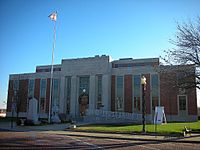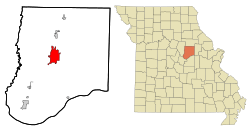Fulton, Missouri facts for kids
Quick facts for kids
Fulton, Missouri
|
|
|---|---|
| City of Fulton | |

Callaway County Courthouse in Fulton
|
|
| Nickname(s):
Tri-Cities (with Columbia and Jefferson City)
|
|

Location of Fulton, Missouri
|
|
| Country | United States |
| State | Missouri |
| County | Callaway |
| Founded | 1825 |
| Incorporated | March 14, 1859 |
| Named for | Robert Fulton |
| Area | |
| • Total | 12.46 sq mi (32.28 km2) |
| • Land | 12.33 sq mi (31.93 km2) |
| • Water | 0.14 sq mi (0.35 km2) |
| Elevation | 801 ft (244 m) |
| Population
(2020)
|
|
| • Total | 12,600 |
| • Density | 1,021.98/sq mi (394.59/km2) |
| Time zone | UTC-6 (Central (CST)) |
| • Summer (DST) | UTC-5 (CDT) |
| ZIP code |
65251
|
| Area code(s) | 573 |
| FIPS code | 29-26182 |
| GNIS feature ID | 2394834 |
Fulton is the biggest city in Callaway County, Missouri. It is also the county seat, which means it's where the county government is located. Fulton is about 22 miles northeast of Jefferson City. It's also 20 miles east of Columbia.
In 2020, about 12,600 people lived in Fulton. The city is home to two universities: Westminster College and William Woods University. You can also find the Missouri School for the Deaf here. Missouri's only nuclear power plant, the Callaway Plant, is located 13 miles southeast of Fulton.
Contents
History of Fulton
The first settlement in Callaway County was in 1809. It was called Cote Sans Dessein. Callaway County was officially formed in 1820. It was named after Captain James Callaway. He was killed by Native Americans.
The Kingdom of Callaway
In 1861, during the American Civil War, Union troops were moving into a nearby county. Colonel Jefferson F. Jones gathered troops to protect Callaway County. They had limited forces. Many soldiers were already fighting elsewhere.
Colonel Jones marched his troops to meet the Union companies. The defense was a clever trick. The troops set up tree logs to look like cannons. In the shadows of their campfires, these logs scared off the Union soldiers.
Talks continued for several days. This led to a ceasefire agreement. It was between the United States of America and Callaway County. Citizens were so happy about this success. They called their county "The Kingdom of Callaway." This name is still used today.
Founding and Growth
Fulton was founded in 1825. It became the county seat that same year. However, it wasn't officially a city until March 14, 1859. The city was first named Volney. This was after a French writer, Constantin François de Chassebœuf.
But just two months later, in 1825, the name changed. It was renamed Fulton to honor Robert Fulton. He was a famous engineer and inventor.
Early residents of Fulton mostly came from the southern United States. They brought enslaved people with them. This helped create an economy based on farming.
Important Institutions in Fulton
By 1884, Fulton was already a special community. The Missouri government decided to build a hospital for people with mental illness in Fulton. This was in 1847. It was the first mental health facility west of the Mississippi River.
In 1851, the government also decided to build a school for the deaf in Fulton. This showed how important education was to the area.
The Presbyterian Church opened a school for girls in 1842. It was later known as Synodical College. In 1851, they also opened an all-male college. This college is now known as Westminster College.
A very famous event happened at Westminster College. On March 5, 1946, Winston Churchill gave his famous "Sinews of Peace" speech. This speech is also known as the "Iron Curtain" speech. President Harry S. Truman was there to hear it.
In 1890, the Christian Church moved its Orphan School to Fulton. Fulton offered $40,000 and 10 acres of land. This school later became William Woods College for Women. Today, it is a university that accepts both male and female students.
Fulton in Books and Movies
Novelist Henry Bellamann was born in Fulton in 1882. He grew up and went to college there. It's believed that Fulton was the inspiration for the fictional town in his novel Kings Row.
In 1940, a movie was made based on the book. The movie starred famous actors like Ann Sheridan, Robert Cummings, and Ronald Reagan. The suit that Ronald Reagan wore in the film is now on display in Fulton. You can see it at the Callaway Chamber of Commerce offices.
Historic Places in Fulton
Several buildings and areas in Fulton are listed on the National Register of Historic Places. This means they are important historical sites. Some of these include the M. Fred Bell Rental Cottage, the George Washington Carver School, and the Westminster College Historic District. You can also visit Fulton's Downtown Brick District.
Geography of Fulton
Fulton is located in the middle of Callaway County. It's along U.S. Route 54. The city is about 22 miles northeast of Jefferson City. Columbia is about 20 miles to the northwest.
The city covers a total area of about 12.40 square miles. Most of this area is land, about 12.26 square miles. A small part, about 0.14 square miles, is water.
 |
Millersburg | Kingdom City | Calwood |  |
| Toledo | ||||
| New Bloomfield | Hams Prairie | Reform |
Population of Fulton
| Historical population | |||
|---|---|---|---|
| Census | Pop. | %± | |
| 1870 | 1,585 | — | |
| 1880 | 2,409 | 52.0% | |
| 1890 | 4,314 | 79.1% | |
| 1900 | 4,883 | 13.2% | |
| 1910 | 5,228 | 7.1% | |
| 1920 | 5,595 | 7.0% | |
| 1930 | 6,105 | 9.1% | |
| 1940 | 8,297 | 35.9% | |
| 1950 | 10,052 | 21.2% | |
| 1960 | 11,131 | 10.7% | |
| 1970 | 12,248 | 10.0% | |
| 1980 | 11,046 | −9.8% | |
| 1990 | 10,033 | −9.2% | |
| 2000 | 12,128 | 20.9% | |
| 2010 | 12,790 | 5.5% | |
| 2020 | 12,600 | −1.5% | |
| U.S. Decennial Census | |||
2020 Census Data
In 2020, the census counted 12,600 people in Fulton. There were 3,441 households. The population density was about 1,022 people per square mile.
Most of the people were white (80.63%). About 11.21% were black or African-American. About 2.4% of the population identified as Hispanic or Latino.
About 19.9% of the population was under 18 years old. The average age in the city was 32.4 years.
Education in Fulton
Fulton has many schools for different age groups.
Colleges and Universities
Westminster College and William Woods University are the two main colleges in Fulton. Long ago, from 1842 to 1928, Fulton was also home to Synodical College. This was one of the first colleges for women in the United States.
Schools for Younger Students
The Fulton 58 School District has several schools. These include Bartley Elementary, Bush Elementary, and McIntire Elementary for grades K-5. Fulton Middle School serves grades 6-8. Fulton High School is for grades 9-12.
There are also private schools like St Peters Catholic School (K-8) and Kingdom Christian Academy (K-11).
The Missouri School for the Deaf is also in Fulton. It is a state school for students who are deaf.
Public Library
Fulton has a public library. It is a part of the Daniel Boone Regional Library system.
Museums in Fulton
Fulton has several museums that tell its unique story.
National Churchill Museum
The National Churchill Museum is in Fulton. It honors Winston Churchill and his famous "Iron Curtain" speech. This speech brought many world leaders to Westminster College. These leaders included Lech Wałęsa, Margaret Thatcher, and several U.S. Presidents like Harry S. Truman and Ronald W. Reagan.
After the Berlin Wall came down, Churchill's granddaughter got a piece of it. She used it to create a sculpture called "Break Through." You can see it on the Westminster College campus. The museum also includes the Church of St Mary the Virgin, Aldermanbury. This church was taken apart in London, England, and rebuilt on the Westminster campus. It marks Churchill's visit.
Other Museums
Other museums in Fulton show the history of the "Kingdom of Callaway." The Fishback Museum focuses on the history of the Missouri School for the Deaf. The Auto World Museum shows how transportation has changed over time.
The Historical Society has photos, family research, and history books. The Brick District Playhouse is in the old Fulton Theatre. It has items from the "King's Row" movie.
Notable People from Fulton
Many interesting people have come from Fulton:
- William F. Baker, an engineer who worked on the Burj Khalifa.
- Nick Cave, a fabric sculptor and artist.
- Henry Bellamann, the author of Kings Row.
- Tony Galbreath, a running back in the National Football League.
- Michael Kim, an ESPN anchor.
- Bake McBride, a Major League Baseball outfielder.
- Laura Redden Searing, a deaf poet and writer.
- Helen Stephens, a 1936 Olympic Champion runner, also known as "The Fulton Flash."
Images for kids
See also
 In Spanish: Fulton (Misuri) para niños
In Spanish: Fulton (Misuri) para niños



